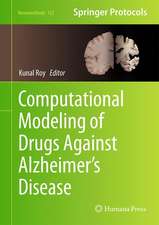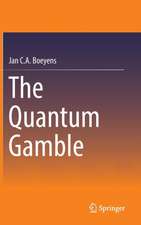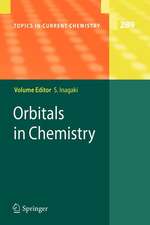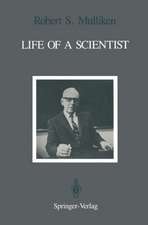Advances in QSAR Modeling: Applications in Pharmaceutical, Chemical, Food, Agricultural and Environmental Sciences: Challenges and Advances in Computational Chemistry and Physics, cartea 24
Editat de Kunal Royen Limba Engleză Hardback – 7 iun 2017
The book covers theoretical background and methodology as well as all current applications of Quantitative Structure-Activity Relationships (QSAR). Written by an international group of recognized researchers, this edited volume discusses applications of QSAR in multiple disciplines such as chemistry, pharmacy, environmental and agricultural sciences addressing data gaps and modern regulatory requirements. Additionally, the applications of QSAR in food science and nanoscience have been included – two areas which have only recently been able to exploit this versatile tool.
This timely addition to the series is aimed at graduate students, academics and industrial scientists interested in the latest advances and applications of QSAR.
| Toate formatele și edițiile | Preț | Express |
|---|---|---|
| Paperback (1) | 2482.06 lei 6-8 săpt. | |
| Springer International Publishing – 2 aug 2018 | 2482.06 lei 6-8 săpt. | |
| Hardback (1) | 2488.36 lei 6-8 săpt. | |
| Springer International Publishing – 7 iun 2017 | 2488.36 lei 6-8 săpt. |
Din seria Challenges and Advances in Computational Chemistry and Physics
- 18%
 Preț: 952.09 lei
Preț: 952.09 lei - 18%
 Preț: 971.01 lei
Preț: 971.01 lei - 18%
 Preț: 1382.21 lei
Preț: 1382.21 lei - 18%
 Preț: 1278.02 lei
Preț: 1278.02 lei - 18%
 Preț: 1248.83 lei
Preț: 1248.83 lei - 18%
 Preț: 1831.42 lei
Preț: 1831.42 lei - 18%
 Preț: 1833.78 lei
Preț: 1833.78 lei - 18%
 Preț: 1827.80 lei
Preț: 1827.80 lei - 18%
 Preț: 2099.59 lei
Preț: 2099.59 lei - 18%
 Preț: 1234.62 lei
Preț: 1234.62 lei - 18%
 Preț: 2108.27 lei
Preț: 2108.27 lei - 18%
 Preț: 950.84 lei
Preț: 950.84 lei - 18%
 Preț: 1235.76 lei
Preț: 1235.76 lei - 18%
 Preț: 1398.00 lei
Preț: 1398.00 lei - 18%
 Preț: 1246.78 lei
Preț: 1246.78 lei - 24%
 Preț: 1994.32 lei
Preț: 1994.32 lei - 18%
 Preț: 1226.73 lei
Preț: 1226.73 lei - 18%
 Preț: 2484.74 lei
Preț: 2484.74 lei - 18%
 Preț: 1125.55 lei
Preț: 1125.55 lei - 18%
 Preț: 1119.87 lei
Preț: 1119.87 lei - 18%
 Preț: 786.36 lei
Preț: 786.36 lei - 18%
 Preț: 962.66 lei
Preț: 962.66 lei - 18%
 Preț: 1827.63 lei
Preț: 1827.63 lei - 18%
 Preț: 1114.34 lei
Preț: 1114.34 lei - 15%
 Preț: 643.16 lei
Preț: 643.16 lei - 18%
 Preț: 1105.82 lei
Preț: 1105.82 lei - 18%
 Preț: 1123.19 lei
Preț: 1123.19 lei - 24%
 Preț: 1070.77 lei
Preț: 1070.77 lei - 20%
 Preț: 1165.69 lei
Preț: 1165.69 lei - 18%
 Preț: 1115.94 lei
Preț: 1115.94 lei
Preț: 2488.36 lei
Preț vechi: 3034.58 lei
-18% Nou
Puncte Express: 3733
Preț estimativ în valută:
476.14€ • 496.16$ • 394.25£
476.14€ • 496.16$ • 394.25£
Carte tipărită la comandă
Livrare economică 03-17 aprilie
Preluare comenzi: 021 569.72.76
Specificații
ISBN-13: 9783319568492
ISBN-10: 3319568493
Pagini: 555
Ilustrații: X, 555 p. 132 illus., 71 illus. in color.
Dimensiuni: 155 x 235 x 32 mm
Greutate: 0.97 kg
Ediția:1st ed. 2017
Editura: Springer International Publishing
Colecția Springer
Seria Challenges and Advances in Computational Chemistry and Physics
Locul publicării:Cham, Switzerland
ISBN-10: 3319568493
Pagini: 555
Ilustrații: X, 555 p. 132 illus., 71 illus. in color.
Dimensiuni: 155 x 235 x 32 mm
Greutate: 0.97 kg
Ediția:1st ed. 2017
Editura: Springer International Publishing
Colecția Springer
Seria Challenges and Advances in Computational Chemistry and Physics
Locul publicării:Cham, Switzerland
Cuprins
Performance parameters and validation practices in QSAR modeling.- Towards interpretable QSAR models.- The use of topological indices in QSAR and QSPR modeling.- The Maximum Common Substructure (MCS) search as a new tool for SAR and QSAR.- The universal approach for structural and physico-chemical interpretation of QSAR/QSPR models.- Generative Topographic Mapping approach.- Monte Carlo methods for solution of tasks in Environmental Sciences.- QSAR in Environmental Research.- QSAR applications for environmental chemical prioritization: Biotransformation of chemicals.- QSAR modeling in environmental risk assessment: application to the prediction of pesticide toxicity.- Counter propagation artificial neural network (CP ANN) models for prediction of carcinogenicity of non congeneric chemicals for regulatory uses.- Strategy for identification of critical nanomaterials properties linked to biological impacts: interlinking of experimental and computational approaches.- QSAR/QSPR modeling inthe design of drug candidates with balanced pharmacodynamics and pharmacokinetic properties.- Molecular modeling of food chemicals as potential bioactive compounds.- On application QSARs in Food and Agricultural Sciences: History and Recent Developments.
Notă biografică
Prof. Dr. Kunal Roy is a Professor of the Drug Theoretics and Cheminformatics Laboratory, Department of Pharmaceutical Technology Jadavpur University, Kolkata India. He was previously a Marie Curie International Incoming Fellow and Commonwealth Academic Staff Fellow at the University of Manchester, UK. Prof. Roy has published over 240 articles in peer reviewed journals, two books, one edited book as well as ten book chapters.
Textul de pe ultima copertă
The book covers theoretical background and methodology as well as all current applications of Quantitative Structure-Activity Relationships (QSAR). Written by an international group of recognized researchers, this edited volume discusses applications of QSAR in multiple disciplines such as chemistry, pharmacy, environmental and agricultural sciences addressing data gaps and modern regulatory requirements. Additionally, the applications of QSAR in food science and nanoscience have been included – two areas which have only recently been able to exploit this versatile tool.
This timely addition to the series is aimed at graduate students, academics and industrial scientists interested in the latest advances and applications of QSAR.
Caracteristici
An interdisciplinary overview of recent advances in methodology and all areas of QSAR applications Includes traditional and non-traditional applications of QSAR found in Food Science and Nanoscience Of interest to experimentalists as well as theoreticians Includes supplementary material: sn.pub/extras





























